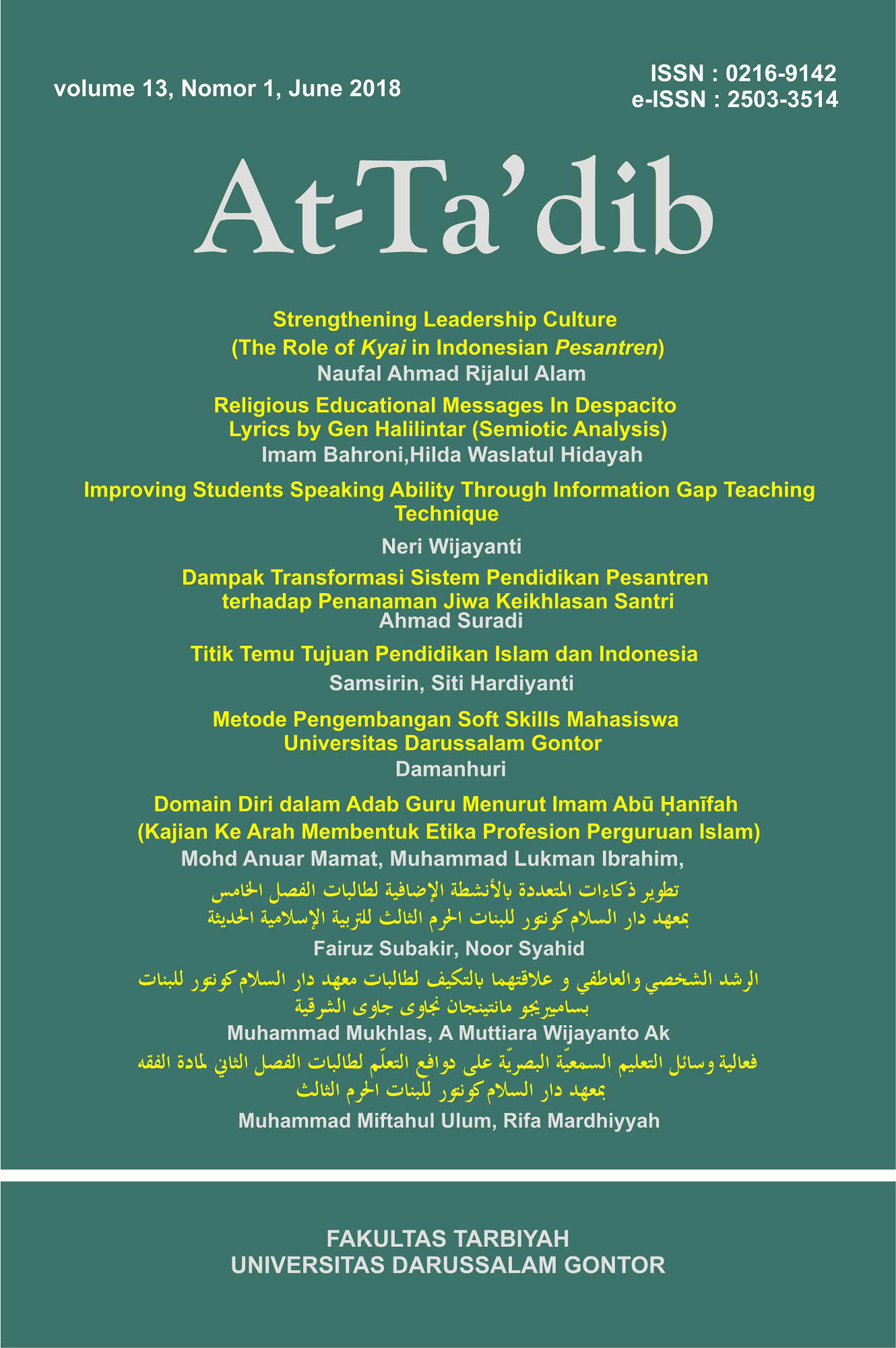Improving Students Speaking Ability Through Information Gap Teaching Technique (A Classroom Action Research at The Second Grade Students of MTs Al-Muhajirin Pacitan)
DOI:
https://doi.org/10.21111/at-tadib.v13i1.2309Keywords:
Information Gap technique, speaking ability, class room action research, teaching speacking, high school student.Abstract
This study is aimed at describing the implementation of Information Gap teaching technique, describing whether or not Information Gap technique improves the students’ speaking ability and describing the students’ response on Information Gap teaching technique in teaching speaking. The study was implemented in MTs Al Muhajirin at the second grade, using action research. The researcher took 40 students as the subject of the research. The researcher teaches speaking English using Information Gap method. To find the results, the researcher got the information from the students’ answers on oral test in the form of pre-test and post-test. The result of the research using information gap shows that, the researcher used the CAR (Class Action Research) principle to collect the data. The study consist of two cycles with each cycle consist of four elements. By implementing Information Gap technique in teaching speaking, the students have chance to be active and cooperative in teaching speaking. The mean of pre-test is 68,7, post-test is 71,6 and the improvement result of the implementation is 2,9. The students’ responses are positive. Most of the students said that they great this technique. They could easily learn English speaking. The students admitted that their speaking was improved.References
Burns, Anne. Doing Action Research in English Language Teaching: A guide for Practitioners. (New York: Routledge. 2010).
Brown, H. Douglas. Teaching By Principles ; An Interactice Approach to Language Pedagogy. (San Francisco: Longman. 2001).
Reeman – Larsen, Diane. Techniques and Principles in Language Teaching. (New York : Oxford University Press. 2000).
Gails, Jean Brewster & Denis Girard. The Primary English Teacher ‘s Guide. (London: Pearson Education Limited. 1992).
Gordon, Thomas. Teacher Effectiveness Training. (Jakarta: Gramedia. 1997).
Harmer, Jeremy. The Practice of English Language. (London: Pearson Education Limited. 2001).
Joyce, Bruce. Model of Teaching. (New Jersey: Prentice Hall. 1996).
Klippel, Friederike. Keep Talking ; Communicative Fluency Activities for Language Teaching. (New York: Cambridge University Press. 2006).
Nunan, David. Research Method in Language Learning. (New York: Cambridge University Press. 1992).
Oxford University Press. Oxford Learner’s Pocket (Dictionary). (New York. 1991).
Richard, Patricia A. — Amato. Making It Happen : From Interactive to Participatory Language Teaching. (New York: Longman. 2003).
Sutopo, H.B. Metodologi Penelitian Kualitatif. (Surakarta: Sebelas Maret University Press. 2002).
Tilson, Christina. Observing Teaching and Learning. (London: David Fulton Publishers. 1998).
Thornburry, Scoot. How to teach Speaking. (London: Pearson Education Limited. 2005).
HYPERLINK “http://(http:/www.eslgold.com/01-10†http://(http://www.eslgold.com/01-10 2011/speaking/information_gap.
html)
www.teachingenglish.org.uk/01-10-2011/think/knowledge-wiki/
inforrnation-gap
Downloads
Submitted
Accepted
Published
How to Cite
Issue
Section
License
Copyright Notice
Authors who publish with this journal agree to the following terms:
- Authors retain copyright and grant the journal right of first publication with the work simultaneously licensed under a Creative Commons Attribution License that allows others to share the work with an acknowledgment of the work's authorship and initial publication in this journal.  Creative Commons Attribution-ShareAlike 4.0 International License.
- Authors are able to enter into separate, additional contractual arrangements for the non-exclusive distribution of the journal's published version of the work (e.g., post it to an institutional repository or publish it in a book), with an acknowledgment of its initial publication in this journal.
- Authors are permitted and encouraged to post their work online (e.g., in institutional repositories or on their website) prior to and during the submission process, as it can lead to productive exchanges, as well as earlier and greater citation of published work.
- The author warrants that the article is original, written by stated author(s), has not been published before, contains no unlawful statements, does not infringe the rights of others, is subject to copyright that is vested exclusively in the author and free of any third party rights, and that any necessary written permissions to quote from other sources have been obtained by the author(s).

AT-TA'DIB: Journal of Pesantren Education Published by Faculty of Tarbiyah, University of Darussalam Gontor, Indonesia is licensed under a Creative Commons Attribution-ShareAlike 4.0 International License.
Based on a work at https://ejournal.unida.gontor.ac.id/index.php/tadib/index








